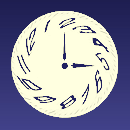

I recently returned from a meeting of the U.S. National Institutes of Health (NIH) Sleep Disorders Research Advisory Board (SDRAB) in Bethesda, Maryland, just outside Washington, DC. I'm an ad hoc member, soon to be a full member, of the SDRAB. The board comprises eight MDs and PhDs plus four patient representatives. The other patient reps have, respectively, narcolepsy, restless leg syndrome (RLS), and sleep apnea. I'm the first patient rep with a circadian rhythm disorder (CRD).
This year the SDRAB is tasked with revising the NIH Sleep Disorders Research Plan, which sets the NIH agenda for sleep disorders research and funding. A couple of months before the meeting, the SDRAB split up into working groups, each responsible for drafting a different section of the research plan. My working group focuses on priorities for clinical research (studies of people as opposed to molecules/DNA/etc) and sleep medicine.
Thanks to the input of members of Facebook and email CRD groups, I compiled a detailed two-page CRD wish list, which I submitted to my working group. We convened by phone several times, then continued brainstorming at the meeting. At the meeting we also heard reports from various NIH agencies that care about sleep (for example, National Highway Traffic Safety Administration, National Institute of Mental Health, National Institute of Diabetes and Digestive and Kidney Diseases, and many more).
Members of the public were welcome to attend the SDRAB meeting. Peter Mansbach, president of Circadian Sleep Disorders Network (CSD-N), gave a short presentation. James Fadden, CSD-N vice president, attended too. A big thank-you to both!
It was heartening to see that at NIH, it's not just "sleep biology," it's "sleep and circadian biology"; it's not just "sleep research," it's "sleep and circadian research"—you get the idea. Circadian rhythms are very much on the radar, and the medical community is waking up to the fact that body clocks regulate a great deal more than sleep.
In addition, I was thrilled to have the ear and attention of key influencers in the sleep medicine community. I stressed that to date, most clinical sleep studies have been conducted on people with normal circadian rhythms. But studying people with disordered rhythms will shed light on the workings of body clocks—benefiting circadian-disordered patients and the entire field of medicine. It's a win-win. (A shout-out to SDRAB member Ken Wright, PhD, director of the Sleep and Chronobiology Lab at the University of Colorado, who backed me up on this and other matters.)
After all was said and done, I'm left with several concerns: